Seroprevalence of Hepatitis B and C viruses and associated factors among medical waste handlers, Northeast Ethiopia
DOI:
https://doi.org/10.20372/ejhbs.v12i2.375Keywords:
Hepatitis, Medical waste handlers, EthiopiaAbstract
Background: Medical waste handlers are at high risk of infections transmitted diseases (by blood, body fluids and sharp objects.) This study aimed to determine the seroprevalence of hepatitis B and C viruses, and associated risk factors among medical waste handlers in Dessie town, northeast Ethiopia.
Method: A cross-sectional study was conducted among medical waste handlers from March to June 2020 in government and private hospitals in Dessie town. Socio-demographic and occupational risk factors were collected using a questionnaire. Serum was tested for hepatitis B surface antigen and anti-hepatitis C antibody using an Enzyme Linked Immunosorbent Assay. The data were analyzed with SPSS version 20. Logistic regression was used to determine the association, and any variable with a p-value of < 0.05 which was considered statistically significant.
Result: The overall seroprevalence of hepatitis B virus a 6.04%, and hepatitis C virus cases were 1.13%. The infections were higher in females with 14 (6.7%) HBV and 3 (1.13%) HCV, and participants with multiple sexual behaviors had 10 (9.5%) HBV. The history of surgical procedures and family history of hepatitis infection were significantly associated factors (P< 0.05).
Conclusion: The prevalence of hepatitis B and C viruses was intermediate and low respectively. The history of surgery and a family history of hepatitis infections were independent factors. Aseptic surgical procedures, awareness of the transmission and implementation of prevention measures in risky settings including home with an infected family member helps to reduce burden of these infections.


